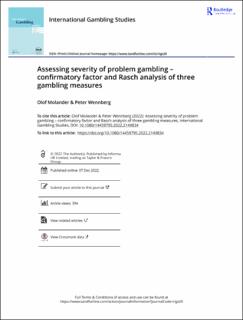Assessing severity of problem gambling–confirmatory factor and Rasch analysis of three gambling measures
Peer reviewed, Journal article
Published version
Date
2022Metadata
Show full item recordCollections
Abstract
The comparative psychometric properties of self-report measures for gambling are insufficiently evaluated, in particular regarding factor structure and item response properties. Confirmatory factor and Rasch analyses were tested for three widely used gambling measures assessing problem gambling and related constructs, that is, the Problem Gambling Severity Index (PGSI), the Problem and Pathological Gambling Measure (PPGM), and the NORC Diagnostic Screen for Gambling Problems (NODS). Psychometric data was analyzed, including help-seeking and recreational gambling samples (N = 598). Compared to the PPGM and the NODS, the PGSI performed worse in the confirmatory factor analysis, and showed poor fit for the theoretically assumed unidimensional model. The Rasch analysis indicated that the PPGM had an adequate difficulty range (i.e. lowest to highest item difficulty) to detect gambling problems across a severity continuum. Compared to the PPGM, the PGSI and NODS had smaller item difficulty ranges, indicating detection of higher gambling severity problems. We conclude that using the PGSI for detection of low severity problems, such as at-risk gambling, might be problematic. The PPGM can be used in general populations and clinical contexts to detect problem gambling and pathological gambling. The NODS is suitable for use in clinical samples for identification of pathological gambling.

